Lysebotn a power plant inside a mountain

Same dam, same amount of water, but more power. A new hydropower plant in western Norway will increase the generation of renewable energy by utilising existing water reservoirs more efficiently.
“We are proud to be heading one of the biggest renewable energy projects in Norway,” says Bjørn Roger Otterdal, Project Director at Lyse, the company behind the new hydropower plant.
The new hydroelectric power plant, Lysebotn 2, will replace the current power plant and produce 15 per cent more clean energy, totalling 1,500 GWh per year.
“That’s enough electricity for 75,000 households every year”, Mr Otterdal says.
Life at the end of the tunnel
Lysefjord is one of Norway’s longest fjords, and the majestic mountains that loom over the fjord on both sides are a tourist attraction.
A tunnel opening at the bottom of one of the mountains reveals that there is more to this landscape than can be seen from the outside. The tunnel leads to a noisy construction site, one and a half kilometres inside the mountain.
“This is a huge project with enormous dimensions”, says Terje Anti Nilsen, Head of Construction at Lysebotn 2. He is shouting at the top of his voice, competing with the noise of five excavators.
“More than 100 people are working here in 12-hour shifts, day and night”, Mr Nilsen adds.
The new power plant will be the size of a ten-storey building when completed, and a total of 11 kilometres of tunnels will have been dug out.
NIB and the Nordic power market
“We are on target and on budget”, Mr Otterdal says about the construction process.
NIB has supplied a NOK 950 million (EUR 113 million) loan to that budget. A loan that, according to Mr Otterdal, is essential to finance a long-term project like Lysebotn 2.
The new power plant is located next to an important junction for Norway’s national power grid.
“We are planning for the future”, Mr Otterdal states, referring to the changes in the Nordic power market.
New cables are connecting the region to the continent and more non-regulated power sources, like wind and sun, are being added to the grid.
Lyse can help maintain a stable voltage and frequency in this new system, according to Mr Otterdal.
“Wind and solar power cannot be regulated and are totally dependent on the weather conditions. With more renewable sources like that in use, it is necessary to have a steady source of power to keep the voltage stable”, Mr Otterdal says, adding that Lysebotn 2 can provide that stability.
A big green battery
Mr Otterdal refers to Lysebotn’s water reservoir as a huge green battery.
“The new plant has the ability to adapt to demand and to provide balancing services to the Nordic market and continental Europe, as well as to the UK in a few years, through the electrical interconnectors”, Mr Otterdal explains.
This ability is an important advantage that Lyse expects to benefit from in the coming years.
Electricity cannot be stored in large quantities. There is a need for instantaneous balance between demand and generation. The energy contained in the reservoirs ensures the plant will be online whenever required.
“Denmark and other countries interconnected with the hydro-dominated Norwegian power system have large amounts of non-adjustable power, mainly wind and solar. We expect hydro-based system services to become more commercially important in the future”, Mr Otterdal says.
“We believe Lysebotn 2 will play an important role in the new market possibilities and contribute substantially to Lyse Group’s revenue in the future”, he adds.
The new hydropower plant is scheduled to commence operations in early 2018.

